CS 3710
Introduction to Cybersecurity
Aaron Bloomfield (aaron@virginia.edu)
@github | ↑ |
Networks
Networking Model
OSI model
- “Open Systems Interconnection” model, developed starting in 1977
- Everybody (including many textbooks!) uses the OSI model diagrams (see next slide), and talks about TCP/IP
- But they are not the same!
- TCP/IP does not fit perfectly into the OSI model
- We don’t care too much about the differences here, so we’ll do that as well
- See here for details
OSI Model
Protocol stack: physical layer
- Is charged with getting data
from one end of the ‘wire’
to the other end - Examples:
- copper wire
- fiber optic cable
- wireless transmission
(WiFi, Bluetooth, satellite
communication), etc.
Protocol stack: data link layer
- Is charged with getting one packet of data from one host to another connected host
- Via the next layer down
- Most common example is Ethernet
- Other examples: ARP, ISDN, PPP, ATM, FDDI
- Although you may use Ethernet, your data will travel over others to its destination, including fiber optic
Protocol stack: network layer
- Is charged with getting a single packet of data from one computer to another (via the next layer down), ‘routing’ the computer between various nodes
- This is the routing in ‘router’
- In TCP/IP, called the “Internet” or “Internet Protocol” (hence “IP”) layer
- Example protocols: IP, ICMP (used for ‘ping’), IPsec (for VPNs)
Internet Protocol (IP)
Protocol stack: transport layer
- Is charged with taking a large piece of data, splitting it into smaller packets, sending each packet to the destination (via the next layer down), and (probably) reassembling it at the destination
- It will (typically) request a missed packet to be re-sent
- Will assemble the packets in order
- Example protocols: TCP, UDP
Transport Control Protocol (TCP)
Protocol stack: session & presentation layers
- Are charged with such tasks as managing network sockets, compressing/encoding/ encrypting the data, etc.
- These layers do not exist in the TCP/IP model!
- This functionality is included in the TCP/IP application layer
- Example protocols: TLS, SSL, NetBIOS
Protocol stack: application layer
- Is the top-level protocol used to communicate to the application on the other end
- Example protocols: DHCP, DNS, FTP, HTTP, IMAP, NTP, POP, SMTP, SSH
More about TCP/IP
- TCP/IP, more accurately called the Internet Protocol Suite, is a full suite of protocols
- Application layer: BGP, DHCP, DNS, FTP, HTTP, HTTPS, IMAP, LDAP, MGCP, MQTT, NNTP, NTP, POP, ONC/RPC, RTP, RTSP, RIP, SIP, SMTP, SNMP, SSH, Telnet, TLS/SSL, XMPP, etc.
- Transport layer: TCP, UDP, DCCP, SCTP, RSVP, etc.
- Internet layer: IP, IPv4, IPv6, ICMP, ICMPv6, ECN, IGMP, IPsec, etc.
- Link layer: Link layer , ARP, NDP, OSPF, Tunnels, L2TP, PPP, MAC, Ethernet, DSL, ISDN, FDDI, etc.
Network device terminology
- Node: any device on a network
- Switch: a node that connects networks on the data link layer only
- Also called a bridge
- Router: a node that connects networks on the network layer
- Gateway: a node that connects two networks that (potentially) use different protocols
- Also translates addresses, etc.
- Firewall: blocks ‘bad’ traffic (more on this in a few slides)
Basic Network Security
Firewall
- A firewall prevents unrequested network connections from outside hosts
- Typically part of a residential ‘gateway’ or ‘router’
- It isolates the ‘inside’ network and the ‘outside’ network
- If you request data (a http connection), the sent data is then ‘requested’ data, and is allowed to pass through
- You can ‘poke a hole’ in a firewall to allow access to a certain port (such as ssh)
Firewall types
- Packet filter: removes packets based on the information in their TCP packet (source, destination, port, etc) - can filter out individual hosts this way
- Circuit-level gateway: forces all data to a given host or network to go through a single gateway, which manages security
- Application-level gateway: only allows specific application-level data through (ssh, but not http, for example)
Firewall types
- Residential ‘firewalls’ do all three
- 1 (packet filter) is usually not done by the typical user
- 2 (circuit-level gateway) is by their very design
- 3 (application-level gateway) is what most people do when configuring their residential firewalls
TCP attacks
- Imagine Alice is sending something to Bob
- A host between Alice and Bob, Mallory, can intercept (and potentially discard) these packets
- Similar to a man-in-the-middle attack
- But to modify the packets, the attacker would have to know the TCP state
- Starting sequence numbers, port numbers, etc.
- These are often easily guessable
- Ports are well-known
- Sequence numbers are often predictable
TCP attacks
- If Mallory can guess the state, then s/he can impersonate one or the other (or both), thus hijacking the connection
- Instead of downloading a valid program from a trusted website, instead you are now downloading some type of malware
- How can we prevent this?
- By keeping anybody from figuring out the state of the TCP connection
- This state is discernible from the TCP packet headers
IP Security (IPsec)
- IPsec is a protocol suite designed to allow encryption of IP packets (at the Network level)
- Other similar ones exist: TLS (Transport Layer Security) does something similar at the Transport level
- SSL (Secure Sockets Layer) is the predecessor to TLS
- Other similar ones exist: TLS (Transport Layer Security) does something similar at the Transport level
- Allows for authentication, exchange of cryptographic keys, and encryption/decryption of IP data packets
- Encryption is via AES
Virtual Private Network (VPN)
- A firewall differentiates between ‘inside’ and ‘outside’ to allow more access to those ‘inside’
- How, then, does a (valid) user have that level of access from the ‘outside’?
- Example: using UVa’s library’s access for online books and what-not
- It’s allowed on-grounds (technically, for any computer in the virginia.edu domain)
- But not off-grounds (such as from va-67-76-91-214.dyn.embarqhsd.net)
- The answer: VPNs
Virtual Private Network (VPN)
- A VPN makes potentially vastly separated IP addresses appear to be a single (virtual) private network
- Then, the access is provided to that private network
- Keeps one from having to construct one’s own private network (expensive)
- It matters not what type of ISP the user is on
- Typically requires a setting or two in a residential ‘gateway’ (specifically, IPsec)
WiFi encryption
- This encrypts all data sent over a wireless network
- This encryption is done at the network or data-link level
- Application-level encryption (https, ssh, imaps, etc.) is on top of WiFi encryption
- There are two types
- Wired Equivalent Privacy (WEP)
- WiFi Protected Access (WPA and WPA2)
Wired Equivalent Privacy (WEP)
- It does not stand for “Wireless Encryption Protocol”
- Created in 1997 to provide confidentiality comparable to that of a traditional wired network
- Security weaknesses were identified in 2001
- In 2003, WEP was replaced by WPA (and, later, WPA2)
WEP weaknesses
- It uses a stream (aka character) cipher RC4 to encrypt each packet
- RC4 is (essentially) secure, but one weakness is that repeated keys can allow an RC4 encoded message to be cracked
- There is one RC4 key, and many different initialization vectors or IVs; one IV for each packet
Encryption without IVs
Encryption with IVs
WEP weaknesses
- WEP uses 24-bit IVs
- Because of the way the IVs are used, there is a 50% chance of a key being repeated after 5,000 packets
- This can lead to cracking the RC4 key, and reading all the WEP encrypted data
- On a busy network, this can happen in under 1 minute
WiFi Protected Access (WPA & WPA2)
- In 2003, it was announced that WEP had been superseded by WPA
- WPA2 followed the following year (2004)
- WPA uses RC4 (character cipher); WPA2 uses AES (block cipher) for the data encryption
- Corresponds to IEEE standard 802.11 (for WPA) or 802.11i (for WPA2)
- Still considered ‘secure’ for WiFi encryption
WPA(2) weaknesses
- Password cracking due to weak passwords
- Look-up tables exist for a million different WPA/WPA2 passwords
- Brute force attacks can crack moderate passwords
- A truly random password of 13 characters (from the 95 available) can prevent brute-force attacks
Denial of Service (DoS) attacks
Denial-of-service (DoS) attack
- A website (or other network resource) attempts to provide a service to authorized users
- If one can stop the website or resource, then service is being denied to the proper users
- Hence the name
- It typically is done via flooding the website or resource with network packets, using up its bandwidth
- If done from one host, the site can easily packet-filter out that host
Denial-of-service (DoS) attack
- Thus, it is most often done from many sites
- This is a distributed denial of service (DDoS) attack
- Often done via a zombie botnet
DoS attacks: ping flood
- ICMP is protocol on the Network level, along with IP, and is used for the ‘ping’ command
- A ping flood attack (can only be run as root on most UNIX systems)
- It sends as many pings out as the bandwidth can support
- The (combined) bandwidth of the attacker must be greater than the (combined) bandwidth of the target
DoS attacks: SYN flood
- In TCP (transport level), a SYN packet starts a ‘handshake’ to open up a connection
- Response is an ‘ACK’ acknowledging the SYN
- Then another ACK acknowledging the first ACK
DoS attacks: SYN flood
- A SYN flood attack sends a TCP SYN packet with a forged ‘from’ field
- Each SYN packet is treated like a connection request
- The target site will span a half-open connection, send a ACK, and wait until it (never) arrives
- This saturates the number of connections the attacked server can make, causing it to be unresponsive to the legitimate users
DoS attacks: reflected attack
- Instead of forging a non-existent source address, make the source be the target machine
- Then, when the target sends a reply (which is automatically done with many types of network datagrams), it goes back to the target, using up their bandwidth a second time
DoS attacks: teardrop attacks
- Sending mangled IP fragments with overlapping, over-sized payloads to the target
- Due to a bug in the TCP/IP fragmentation re-assembly code, this would crash the operating system
- This bug has long since been patched (in 1999/2000), but was existent on Windows 3.1x, 95, and NT, as well as Linux versions prior to 2.0.32 and 2.1.63
- This means that just sending a “bad” network packet to a computer would crash that computer!
DoS attacks: brute force
- Not very elegant, but very effective
- Just flood the machine with requests, such as http GET
- This does not require much knowledge, just access to a lot of computers
- Probably via a zombie botnet
Wireshark
Obtaining Wireshark
- Download it at wireshark.org/download.html; the Windows version that runs without a full install is here
“Normal” pcaps
- Example http request: http.pcap (from here)
- Telnet (from here):
- In “cooked” (per-line) mode: telnet-cooked.pcap
- In “raw” (per-character) mode: telnet-raw.pcap
http webmail login
- Google search for: inurl:“http://webmail”
- Then find one that allows login via http (many redirect to https)
- Start up wireshark, set your filter
- Example:
ip.src==1.2.3.4 and http - Use your IP, of course
- Example:
- See http-webmail.pcap
Malicious pcaps
- Teardrop attack: teardrop.pcap; packets 8 and 9 overlap (from here)
- SYN flood: syn-flood.pcap (from here)
Obtaining pcaps
- Wireshark’s sample captures page
- Has both links to other sites (may outdated) and many pcaps
- https://www.netresec.com/?page=PcapFiles
- Mostly lists to other sites, but a large list of other sites




